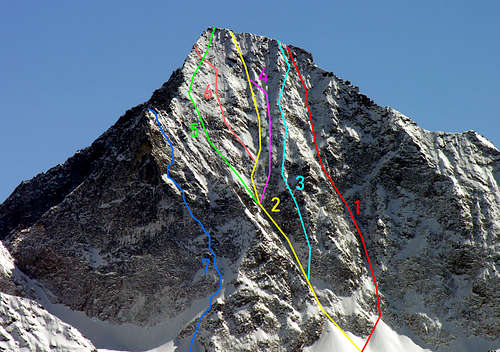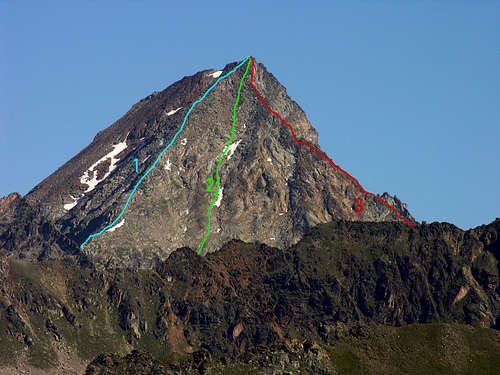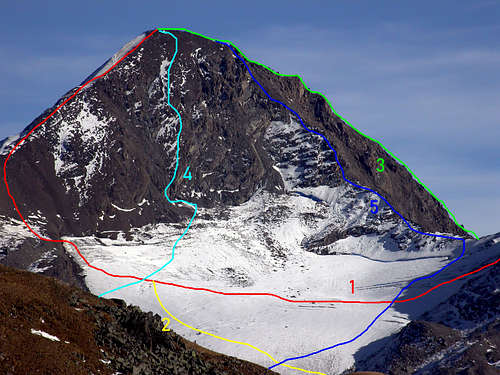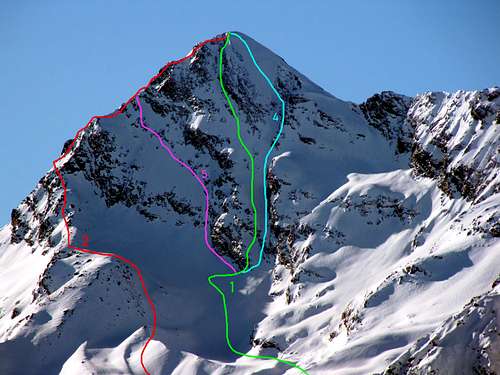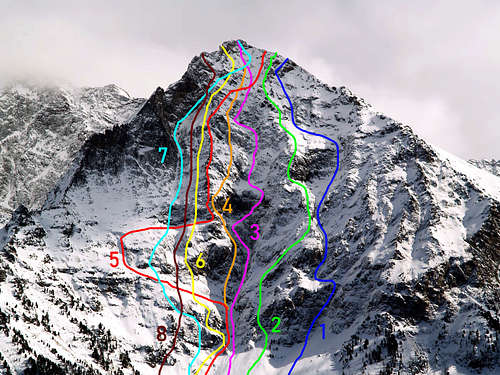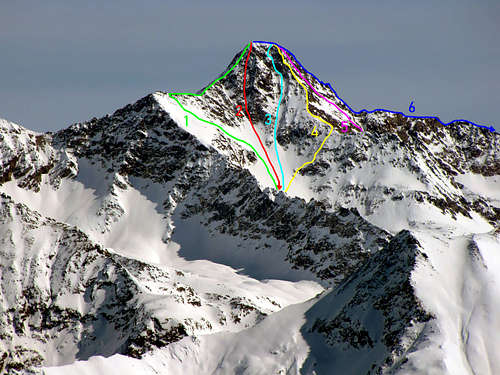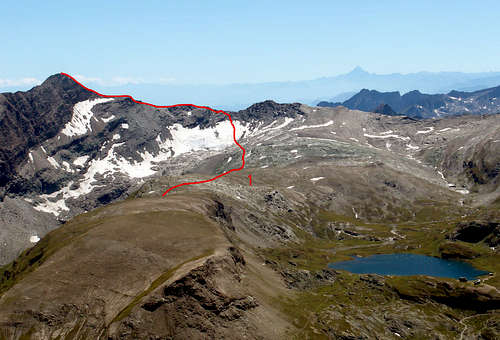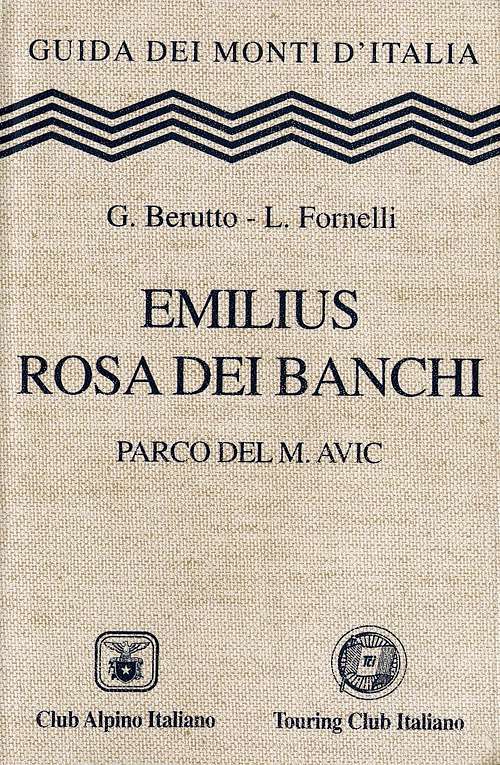-
 1533 Hits
1533 Hits
-
 77.48% Score
77.48% Score
-
 8 Votes
8 Votes
|
|
Route |
|---|---|
|
|
45.67861°N / 7.38396°E |
|
|
Overview
The Monte Emilius Group (3.559m) overall does not have "excellent" walls, but it certainly offers some very challenging and above all delicate ones, due to the often poor quality of the rock structures. In fact, it is formed by rather ancient mountains, on which the erosion of water and ice, thermal changes, as well as the wind have left their mark. Furthermore, the typology of the rock composed mainly of transformed mica schists is easily subjected to the same, even if, at times, intrusions of excellent grayish ecoglitic gneiss and, more rarely, of greenish serpentinite are found. Rock formations made up of calcescists are rarer (Southern side of Tour Ponton (3.101m) and Mont Glacier (3.186m) near Lake Gelato), while as regards the morphology of the whole it is to be ascribed to the structural units of the "Austroalpine Lembi" (strips). Unfortunately, this type of rock presents itself to mountaineers with rocks that are not always very safe and, often, broken if not friable. This concept is valid for all the subgroups (Punta Tersiva, Mont Glacier, Monte Avic etc.) of this vast area belonging to the Southeast Graian Alps (to the East and Northeast of the Gran Paradiso Group) now on the border with the Piedmont Region. For which, in terms of the type of activity, it is an area more suited to Hiking than not aimed at Mountaineering. Even if there is no shortage of beautiful climbing routes, not easy and sometimes very demanding (East Face above the Vallone delle Laures) if not extreme (as on the Black Triangle of Monte Emilius, robust forepart next to the North Face that reaches 3.378 meters on the N-NE Corner). Other itineraries are to be evaluated between PD (not very difficult) and AD, AD + and up to D (from fairly difficult to difficult), "Crestone" N-NE and Northern and Eastern Walls of Becca di Nona (3.142m), Southern Pillars of Mount Emilius and "Spigolo" (Edge) N-NE, N-NE Face of Becca di Seneva under the rampart of "Lo Cordagnì",Western and Eastern Walls in the Roises Range (3.357m), East Walls of Punta Rossa dello Emilius (3.401m), West and South and above all the NE of Punta or Peak Garin (3.451m), various faces of the Tersiva (3.515m) and in particular the North-Northeast, N-NE and N- Walls NW of Mont Glacier, North and East of Mont Delà, Eastern or Western gullies and coulois of Mont Rafray, Crests of Mont Ruvic or Ruvì (2.922m), and of Monte Avic (3.006m), SE Face of Bec Raty, some routes to Bec l'Espic and to the Southern Slope of Monte Orso.Other routes, even if less "famous" than the Eastern Wall of Monte Emilius, are equally demanding, even if they are shorter. These include the North Face and the East "Crestone" of Bec l'Espic, the North Face of Monte Orso above the Gran Gola, the South Spigolo and the "Diedri" route at Bec Raty. Or classic routes on the ridges of both Monte Emilius and Punta Garin, the Roises or Roèses Chain, the Tersiva, and Mont Delà (3.139m), of the Rosa dei Banchi (3.164m) etc. There are equipped routes or "Via Panorama" on the watershed crest between Punta de la Pierre and Testa Nera (2.820m), climbing over the higher altitude of Punta della Valletta (3.090m) and from Bivacco Federigo to Colle Carrel (2.907m) climbing above Mont Ròss de Comboé and the Piccolo Emilius (3.342m) via the long Northwest Ridge. However, this last one has destroyed the charm of the wild and intact ridge which from 1902 to 2004 had only registered a dozen ascents .. Today it is for almost everyone ...
Il Gruppo del Monte Emilius (3.559 m) complessivamente non presenta pareti "eccelse", ma sicuramente ne offre alcune decisamente impegnative e soprattutto delicate, causa la spesso non buona qualità delle strutture rocciose. Infatti il medesimo é formato da montagne alquanto antiche, sulle quali l'erosione delle acqua e del ghiaccio, i cambiamenti termici, nonché il vento hanno lasciato il segno evidente. Inoltre la tipologia della roccia composta prevalentemente da micascisti trasformati si assoggetta facilmente agli stessi, anche se, a volte, si riscontrano intrusioni di ottimo gneiss ecoglitico grigiastro e, più raramente, di verdastra serpentinite. Più rare le formazioni rocciose composte da calcescisti (versante Meridionale della Tour Ponton (3.101 m) e Mont Glacier (3.186 m) nei pressi del Lago Gelato), mentre in quanto alla morfologia del tutto é da ascrivere alle unità strutturali del "Lembi Austroalpini". Purtroppo questa tipologia rocciosa si presenta agli alpinisti con rocce non sempre molto sicure e, spesso, rotte se non addirittura friabili. Questo concetto vale un pò per tutti i sottogruppi (Punta Tersiva, Mont Glacier, Monte Avic ecc.) di questa vasta area appartenente alle Alpi Graie Sudorientali (ad Oriente e Nordest rispetto al Gruppo del Gran Paradiso) ormai al confine con la Regione Piemonte. Per la qual cosa, in quanto alla tipologia di attività, si tratta di una zona più consona allo Escursionismo che non rivolta allo Alpinismo. Anche se non mancano percorsi di arrampicata belli, non facili ed a volte molto impegnativi (Parete Est soprastante il Vallone delle Laures) se non estremi (come sul Triangolo Nero del Monte Emilius, robusto avancorpo a fianco della Parete Nord che raggiunge i 3.378 metri sullo Spigolo N-NE). Altri itinerari sono da valutare tra il PD (poco difficile) e lo AD, AD+ e fino a D (da abbastanza difficile a difficile), "Crestone" N-NE e Pareti Settentrionale ed Orientale della Becca di Nona (3.142 m), i Pilastri a Sud del Monte Emilius e Spigolo N-NE, Parete N-NE della Becca di Seneva al di sotto il bastione de "Lo Cordagnì", Pareti Occidentali ed Orientali nella Catena delle Roises (3.357 m), Pareti Est della Punta Rossa dello Emilius (3.401 m), Ovest e Sud e soprattutto la Nordest della Punta Garin (3.451 m), pareti varie della Tersiva (3.515 m) ed in particolare la Nord-nordest, Pareti N-NE e N-NO del Mont Glacier, Nord ed Est del Mont Delà, Canaloni Orientali od Occidentali del Mont Rafray, Creste del Mont Ruvic o Ruvì (2.922 m), e del Monte Avic (3.006 m), Parete SE del Bec Raty, alcune vie al Bec l'Espic ed al Versante Meridionale del Monte Orso. Altre vie, anche se meno "famose" della Parete orientale del Monte Emilius, sono altrettanto impegnative, anche se di più corto respiro. Tra queste la Parete Nord ed il "Crestone" Est del Bec l'Espic, la Parete Nord del Monte Orso al di sopra della Gran Gola, lo Spigolo Sud e la via sei "Diedri" al Bec Raty. Oppure percorsi classici sulle creste sia del Monte Emilius che della Punta Garin, della Catena delle Roises o Roèses, della Tersiva, del Mont Delà (3.139 m). della Rosa dei Banchi (3.164 m) ecc. Esistono vie attrezzate o "Via Panorama" sulla cresta spartiacque tra la Punta de la Pierre e la Testa Nera (2.820 m) scavalcando la maggiore altitudine della Punta della Valletta (3.090 m) e dal Bivacco Federigo al Colle Carrel (2.907 m) scavalcando il Mont Ròss de Comboé ed il Piccolo Emilius (3.342 m) tramite la lunga Cresta Nordovest. Questa ultima ha però distrutto il fascino della selvaggia ed integra cresta che dal 1902 al 2004 aveva fatto registrare appena una decina di ascensioni.. Oggi é per tutti, quasi ...
Fist Ascents
Monte Emilius (3.559m):
- First on the Summit: Giovan Battista Defey, Lorenzo Cerise and a company unmentionable, (Summer 1823), in ascent from Arbolle Valley.
Punta Tersiva (3.515m):
- Firs Ascent W Arête: P. B. Chamonin (Curate of Cogne) with a student, (Aug 23th, 1842).
Becca di Nona (3.142m):
- First on the Summit: Engineer Alberto Casalegno topographer by S.M.S., (Summer 1832), in ascent from Comboé Valley and, more probably, Carrel Pass and S-SE Crest.
Punta Garin: (3.451m):
- First on the Summit: Abati B. Chamonin and P. Chanoux, (1856).
Rosa dei Banchi (3.164m):
- First on the Summit: Unknown or Cap. Albert della S.M.S., (1831).
Route Description
|
1) - E Ridge: Abbé Henry and Gregorio Comè, (Sep 16th, 1902). Difficulty PD.
2) - Left route: Ezio Donzel, (Aug 16th, 1975). Difficulty IV+/V.
3) - E Wall: Giusto Gervasutti and Renato Chabod, (Jun 26th, 1935). Difficulty IV/IV+V.
4) - Right Route: Ilario Antonio Garzotto and Renato Quendoz, (Jul 18th, 1969). Difficulty IV+.
5) - NNE Ridge or "dei tre Curati": Abati G. Bonin, J. Henry and Nino Tofani, (Aug 02, th 1902). Difficulty III+/IV.
|
|
1) - Right Gully: Osvaldo Cardellina, lone, (Aug 9th, 1998). Difficulty D.
2) - Left Spur: Lino Binel and Amilcare Crétier, (Aug 21th, 1927). Difficulty IV/V.
3) - Right Spur: Renato Quendoz and Giuseppe Trevisan, (Sep 27th, 1970). Difficulty TD.
4) - Right Channel (ariant): Adolfo Ourla and Emanuele Tosana, (1942).
5) - N Wall (direct line): Osvaldo Cardellina and Camillo Roberto Ferronato, (Aug 31th, 1980). Difficulty D.
6) - Original route: Lino Binel, Renato Chabod and Amilcare Crétier, (Aug 10th,1926).
7) - Black Triangle Route "Bocconi Amari-Senza Parole": Ezio Marlier, (Oct 2006).
|
|
1) - W Arête (from North Face of Little Emilius): Giovan Battista Devalle, Ercole Daniele, Alessandro Pession and Luigi Bich, (Aug 30th, 1897), first Winter and first lone: Nerino Gobbo; in winter (1940/41); difference in lev. 200/220m. Difficulty AD-.
2) - S-SE Arête (Normal Route of "Three Capuchins"): Giovan Battista Defey, Lorenzo Cerise and a company unmentionable, (1823); First Winter (First Absolute in Winter of mountain): Lino Binel and Amedeo Berthod and Leonardo Cossard, (Feb 15th, 1934); difference in lev. 320m. Difficulty F/F+.
3) - S Slope (Right or Eastern rocky-snowy Great Couloir): Abbé Henry and Gregorio Comè, (Sep 02th, 1902); from Arbole; difference in lev. 290/300m; (30°/35°). Difficulty F+/PD-.
4) - S-SW Wall of Great Pillar and W Arête (Integral and Pillar Direct Line to "Grey Fall" and W Crest, new route in left): Osvaldo Cardellina and Danilo Garzotto, (Oct 11th, 1986); difference in lev. 400/410m (350/60+50m). Difficulty AD+/AD/AD+.
|
Essential Gear
Complete alpine equipment.
Attrezzatura alpinistica completa.
Refuges and Bivouacs
Bivacco FEDERIGO ZULLO Colle Carrel (2.907m). Places 9 always opens.
Bivacco LE TRAMAIL Vallone di Laures (1.951m). Places 6/8 always opens.
Bivacco BORROZ-ROTARI VAL CLAVALITÉ Cuneux (2.156m). Places 24.
Bivacco FRANCO NEBBIA Lago Garin (2.753m). Places 6 always opens.
Refuge ALPE ARBOLLE Laghi di Arbolle (2.507m). Places 66, local winter 6 always opens.
Refuge ERNESTO MENABREAZ Laghi di Laures (2.542m). Private, local winter: Places 8/10 always opens.
Books and Maps
BOOKS:
- "Guida delle Alpi Occidentali" di Giovanni Bobba e Luigi Vaccarone C.A.I. Sezione di Torino Volume II (parte II) 25-05-1896.
- "Guida della Regione Autonoma Valle d'Aosta" di Mario Aldrovandi, Ed. S.P.E. di Carlo Fanton Torino 1964.
- "80 itinerari di Escursionismo Alpinismo e Sci Alpinismo in Valle d'Aosta", di Osvaldo Cardellina, Ed. Musumeci, Giugno 1977 (in Italian); seconda Ed. Luglio 1981; terza Ed. Luglio 1984; (in French), prima Ed. Febbraio 1978; seconda Ed. Marzo 1980.
- "Guida dei Monti d'Italia "Emilius Rosa dei Banchi Parco del Mont Avic" di G. Berruto-L. Fornelli - Club Alpino Italiano-Touring Club Italiano, 2005 (in Italian).
- "Ascensioni 1964-1969" Diario Alpinistico di Ilario Antonio Garzotto (unpublished).
- "Diari Alpinistici" di Osvaldo Cardellina e Indice Generale accompagnato da Schedario Relazioni Ascensioni 1964-2019 (unpublished).
MAPS:
- Kompass "Massiccio del Monte Bianco Valle d'Aosta" sentieri e Rifugi Carta turistica 1:50.000.
- Kompass "Gran Paradiso Valle d'Aosta" sentieri e Rifugi Carta turistica 1:50.000.
- Enrico Editore Ivrea-Aosta "Gruppo del Gran Paradiso" 1:50.000.
- I.G.M. Istituto Geografico Militare Maps 1:25.000.
Acknowledgements
The fundamental support given by my friend "Osva" for the "Overview" with translation.



